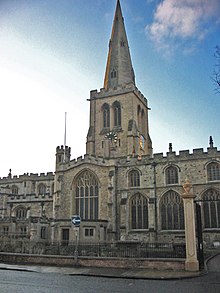St Paul's Church, Bedford
| St. Paul's Church | |
|---|---|
| St. Paul's Church, Bedford | |
 |
|
| Country | England |
| Denomination | Church of England |
| Website | http://www.stpaulschurchbedford.org.uk |
| History | |
| Dedication | Saint Paul |
| Architecture | |
| Status | Parish church |
| Functional status | Active |
| Administration | |
| Deanery | Bedford |
| Archdeaconry | Bedford |
| Diocese | St Albans |
| Province | Canterbury |
| Clergy | |
| Priest(s) | Kevin Goss |
| Laity | |
| Organist/Director of music | Ian Runnells |
St Paul's Church is a Church of England parish church located on St Paul's Square in the town centre of the market and county town of Bedford, Bedfordshire, England. Formerly a medieval collegiate church, the large building of cathedral proportions with its later additions and iconic spire dominates the town, and the church exercises a ministry of welcome to thousands of visitors and pilgrims from far and wide each year.
Historically, St Paul’s has played a key part in the life of the British nation: as the home for the BBC’s daily worship during the Second World War; and the Service for the National Day of Prayer in 1941, at which the then Archbishop of Canterbury, Cosmo Gordon Lang preached, was also broadcast to the UK and wider world from the church. St Paul's is today the Civic Church of the Borough of Bedford and the County of Bedfordshire; it is a focus for special commemorations and celebrations in the borough, county, and the wider region of the East of England, as well as being a central venue for concerts, recitals and exhibitions. As well as serving a diverse parish and ministering to a congregation of all ages, the church also enjoys fine choral and liturgical worship in the English cathedral tradition.
Some evidence exists for the founding of St Paul’s Church as a new minster by King Offa (d.AD796) to serve the inhabitants of his new fortified urban burgh. Offa is understood to have been buried in Bedford and his Minster Church of St Paul has been identified as a possible site of his grave. The church mentioned by name in the Domesday book was a house of secular canons in the eleventh century, ruled by an abbot in 971, and the church in which Oscytel (or Oskytel), Archbishop of York was buried in 956, indicating that St Paul’s was an important minster church from at least the tenth century onwards.
From the early ninth century the priests’ mission was frequently interrupted by the invasions of the heathen Danes which continued at intervals until the arrival of the Normans in 1066. The Danes caused sporadic damage wherever they plundered or settled. They used the river to move inland to Bedford on their way westwards into the Saxon kingdoms of Mercia and Wessex, and in 1009-10 destroyed the church in the fighting. The Anglo-Saxon chronicles report that ‘forever they burnt as they went, then they turned back to the ships with their booty’.
...
Wikipedia
